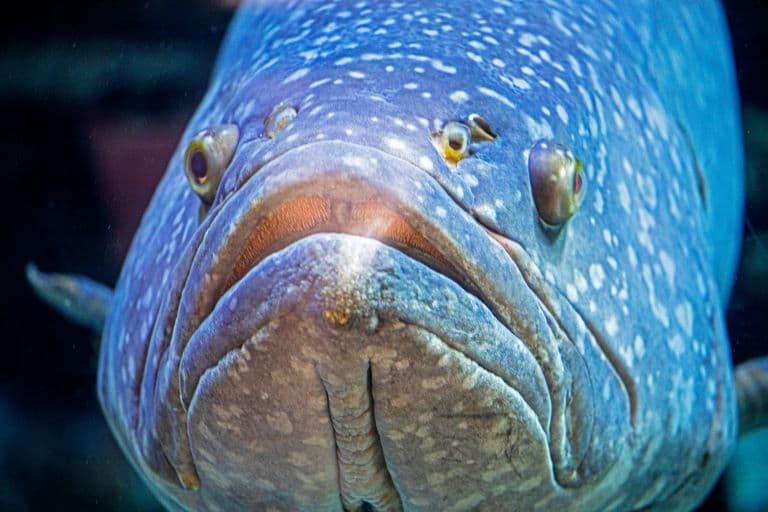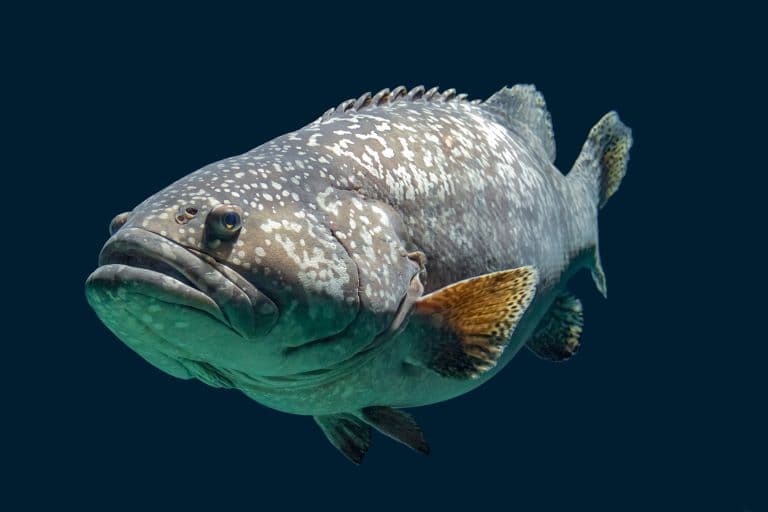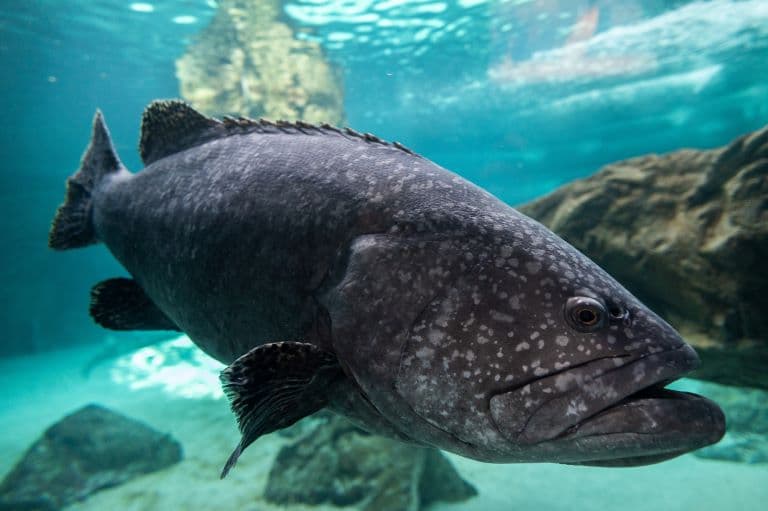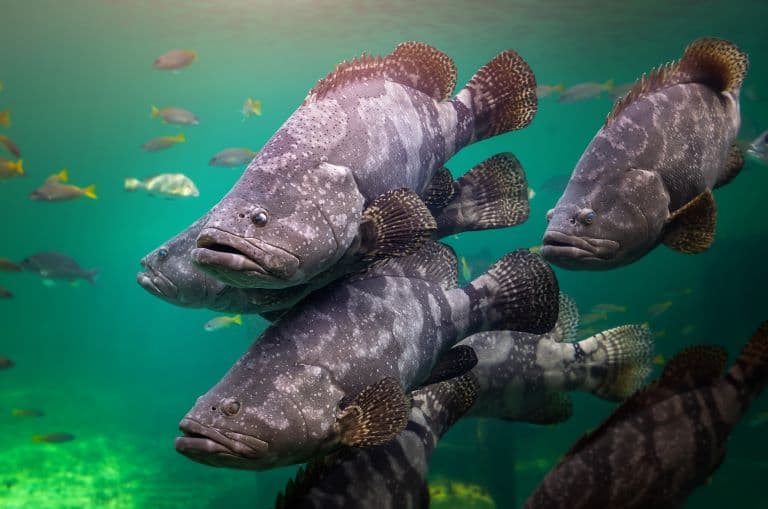Giant Grouper Profile
Outside of your washing up cloths and sponges, the marine reef might be the most biodiverse ecosystem on Earth. So for something to hold a record here, it has to be truly impressive. And the largest bony fish on the reef is just that. The giant grouper is a half-ton patrolling sentinel of bass face and curiosity and it’s a sight to behold.
Also known as the Queensland grouper, this nickname dramatically under-represents such a worldwide, epic beast.

Giant Grouper Facts Overview
| Habitat: | Coastal waters, marine |
| Location: | From the Red Sea to South Africa and eastward to the Hawaiian and Pitcairn Islands; Japan to Australia |
| Lifespan: | 30-50 years, possibly up to 100 |
| Size: | Up to 2.7 m (8 ft 10 in) long |
| Weight: | Up to 400kg (880 lb) |
| Colour: | Patterned yellow and black in juveniles, adults more uniform grey with dark bars |
| Diet: | Opportunistic predator: fish, sharks, turtles crustaceans, molluscs |
| Predators: | Few, mostly other groupers |
| Top Speed: | Unknown, slow |
| No. of Species: | 1 |
| Conservation Status: | Data Deficient (IUCN) |
These huge fish are bass-adjacent, reef specialists who suck up prey in ambush whenever they come across it. They’re not fussy eaters, and they’re genuinely curious about what you’re bringing to feed them. They occupy more reefs than any other grouper species, and they live a slow life, maturing in their own time, and transitioning between sexes as they go.
They are generally very docile, and nobody who’s ever been swallowed by one has lived to tell the tale.
Interesting Giant Grouper Facts
1. They’re bass
Groupers like this one are members of the Serranidae, which includes, among the 450 species, some tiny individuals of around 10cm long. This is the sea bass family, and home to some of the more colourful fish in the ocean.
While colourful, the giant grouper is anything but petite: this is the largest member of the family, at the other end of the spectrum, growing up to 2.7 meters long, and weighing up to 400 kg.
An animal this cumbersome is still relatively good-looking (at least, that’s what my mother tells me) and surprisingly mobile, and the giant grouper certainly gets around. 1

2. They are the most widely distributed species of grouper in the world
Of the 234 known species of grouper, this one is the most cosmopolitan. It exists in coastal waters all the way from the Red Sea, down Africa to the Cape, Around Hawaii islands to Japan, South Asia and Australia, where it gets its other name, the Queensland grouper.
Quite Frankly it’s quite rude to claim such a widespread animal for a single state, but nobody’s going to argue with Australians when it comes to animals.
3. They’re curious
Despite their worldly experience, there are still things these fish find fascinating. Divers are one of them, and this species is well known for being very interested in who you are and what you’re doing here.
They are generally slow-moving, gentle giants, and likely intelligent animals who know full well that the greasy apes bring lots of chum for them to feed on when they enter the habitat. 2

4. They mature slowly
The monster adults of this species take a long time to get to full size. It can be decades before a giant like this will stop growing and they can live potentially up to around 50 years old.
Zanzibar is one of their seasonal spawning sites, as is Paua New Guinea, the Maldives, and eastern Indonesia.
They have a generally good mortality rate naturally, but the life history data is sorely lacking. It’s thought they reach sexual maturity at around six years of age. 3
5. They’re one of the largest species of bony fish
Despite its name, the Goliath grouper is just behind the giant grouper in the size rankings. This makes the giant grouper the biggest fish on the reef and one of the biggest bony fishes in the ocean.
They are most commonly found in warm shallow reefs, but also in estuarine waters, caves and wrecks, too.
6. They’re hermaphrodites
Recent research into this species has shown that it’s a diandric protogynous hermaphrodite. This mouthful means that there are two types of male giant grouper.
The first is a male that’s born a male and matures into an adult male, and the second is a female that grows up to become a male. That’s the diandric part of the term.
The protogynous hermaphrodite part means that animals are born as females and then mature into males.
Only half of this was known until 2021 when researchers, who thought all groupers were born female, discovered that some mature into males without passing through their female stage.
Sadly, most of the excitement for this discovery is around how to farm them so that they can still be eaten without going extinct. This is both good and bad news. 4

7. They respond to chemo
Pet lovers will go to great lengths to keep their animals free from harm. Perhaps one of the most unusual examples of this was the giant grouper called Bubba, who underwent chemotherapy for cancer in a Chicago aquarium.
It worked! And he became the first such fish to ever receive the treatment.
8. They’re decreasing in number
Cancer isn’t of major concern to wild populations, however, as they don’t live long enough to get it. Overfishing is destroying grouper habitats, grouper food supply, and the groupers themselves, who get tangled up in the all the nets we keep putting out there.
A worrying lack of data has this species listed as Data Deficient by the IUCN, so it’s hard to know how serious this is at the moment, but their numbers are definitely dropping.
9. Do they kill people?
Saying that “Reports of fatal attacks on humans are unconfirmed” is like saying “Elon Musk denies molesting a family of mongooses”. It’s a cop-out way of putting an idea out there and refusing to stand behind it with any evidence at all.
With that disclaimer out of the way, there are unconfirmed claims of groupers attacking and even killing divers.
They’re certainly big enough, and if a fully grown grouper fell out of a window and landed on a person it could certainly do some damage, but so far we can neither confirm nor deny these rumours.
On the whole, though, these big fish are very gentle and curious and rarely, if ever, bite a person’s head clean off.
Giant Grouper Fact-File Summary
Scientific Classification
| Kingdom: | Animalia |
| Phylum: | Chordata |
| Class: | Actinopterygii |
| Order: | Perciformes |
| Family: | Serranidae |
| Genus: | Epinephelus |
| Species: | lanceolatus |
Fact Sources & References
- Mike Rimmer (2019), “Epinephelus lanceolatus (giant grouper)”, Cabi Digital Library.
- Insider (2018), “Meet the Goliath Grouper Fish”, YouTube.
- “Goliath Grouper”, Florida Fish and Wildlife Conservation Comission.
- Peter Palma (2019), “Reproductive development of the threatened giant grouper Epinephelus lanceolatus”, Science Direct.
